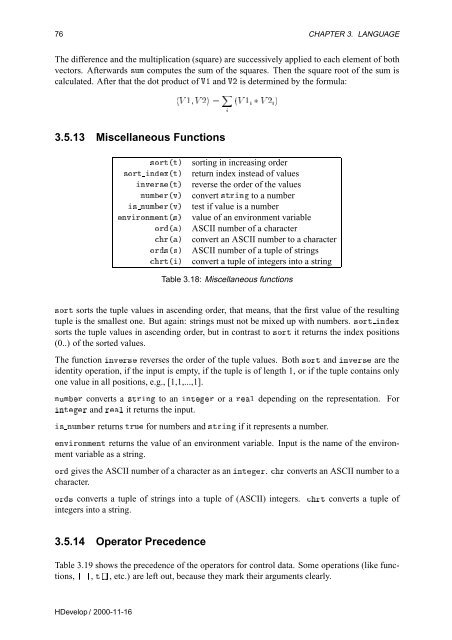Create successful ePaper yourself
Turn your PDF publications into a flip-book with our unique Google optimized e-Paper software.
76 CHAPTER 3. LANGUAGE<br />
The difference and the multiplication (square) are successively applied to each element of both<br />
vectors. Afterwards ×ÙÑ computes the sum of the squares. Then the square root of the sum is<br />
calculated. After that the dot product of ν and ξ is determined by the formula:<br />
Î ½Î¾ <br />
<br />
<br />
´Î ½ £ Î ¾ µ<br />
3.5.13 Miscellaneous Functions<br />
×ÓÖشص sorting in increasing order<br />
×ÓÖØ Òܴص return index instead of values<br />
ÒÚÖ״ص reverse the order of the values<br />
ÒÙÑÖ´Úµ convert ×ØÖÒ to a number<br />
× ÒÙÑÖ´Úµ test if value is a number<br />
ÒÚÖÓÒÑÒØ´×µ value of an environment variable<br />
ÓÖ´µ ASCII number of a character<br />
Ö´µ convert an ASCII number to a character<br />
ÓÖ×´×µ ASCII number of a tuple of strings<br />
ÖØ´µ convert a tuple of integers into a string<br />
Table 3.18: Miscellaneous functions<br />
×ÓÖØ sorts the tuple values in ascending order, that means, that the first value of the resulting<br />
tuple is the smallest one. But again: strings must not be mixed up with numbers. ×ÓÖØ ÒÜ<br />
sorts the tuple values in ascending order, but in contrast to ×ÓÖØ it returns the index positions<br />
(0..) of the sorted values.<br />
The function ÒÚÖ× reverses the order of the tuple values. Both ×ÓÖØ and ÒÚÖ× are the<br />
identity operation, if the input is empty, if the tuple is of length 1, or if the tuple contains only<br />
one value in all positions, e.g., [1,1,...,1].<br />
ÒÙÑÖ converts a ×ØÖÒ to an ÒØÖ or a ÖÐ depending on the representation. For<br />
ÒØÖ and ÖÐ it returns the input.<br />
× ÒÙÑÖ returns ØÖÙ for numbers and ×ØÖÒ if it represents a number.<br />
ÒÚÖÓÒÑÒØ returns the value of an environment variable. Input is the name of the environment<br />
variable as a string.<br />
ÓÖ gives the ASCII number of a character as an ÒØÖ. Ö converts an ASCII number to a<br />
character.<br />
ÓÖ× converts a tuple of strings into a tuple of (ASCII) integers. ÖØ converts a tuple of<br />
integers into a string.<br />
3.5.14 Operator Precedence<br />
Table 3.19 shows the precedence of the operators for control data. Some operations (like functions,<br />
, Ø℄, etc.) are left out, because they mark their arguments clearly.<br />
<strong>HDevelop</strong> / 2000-11-16
















